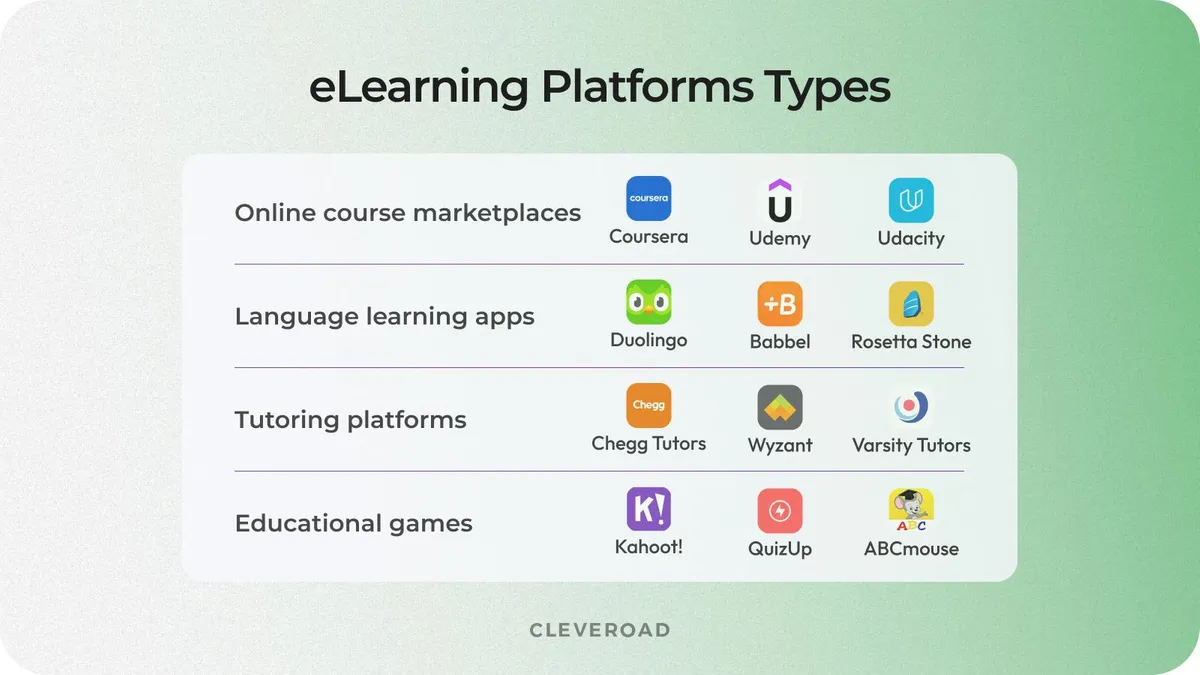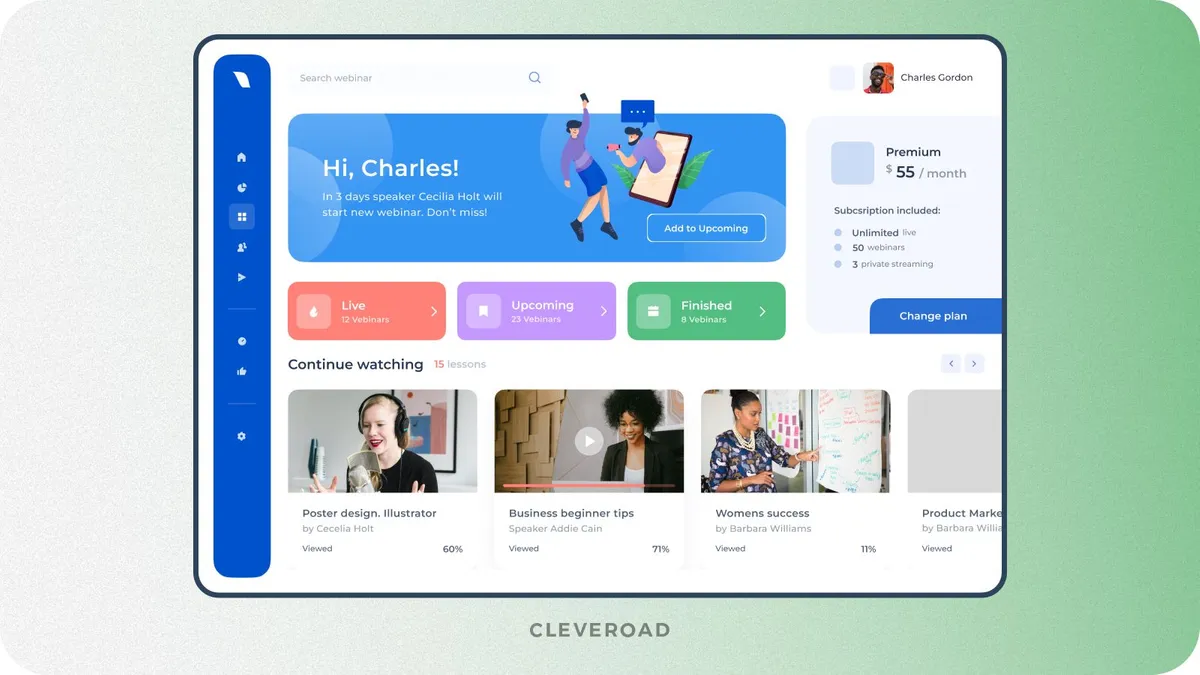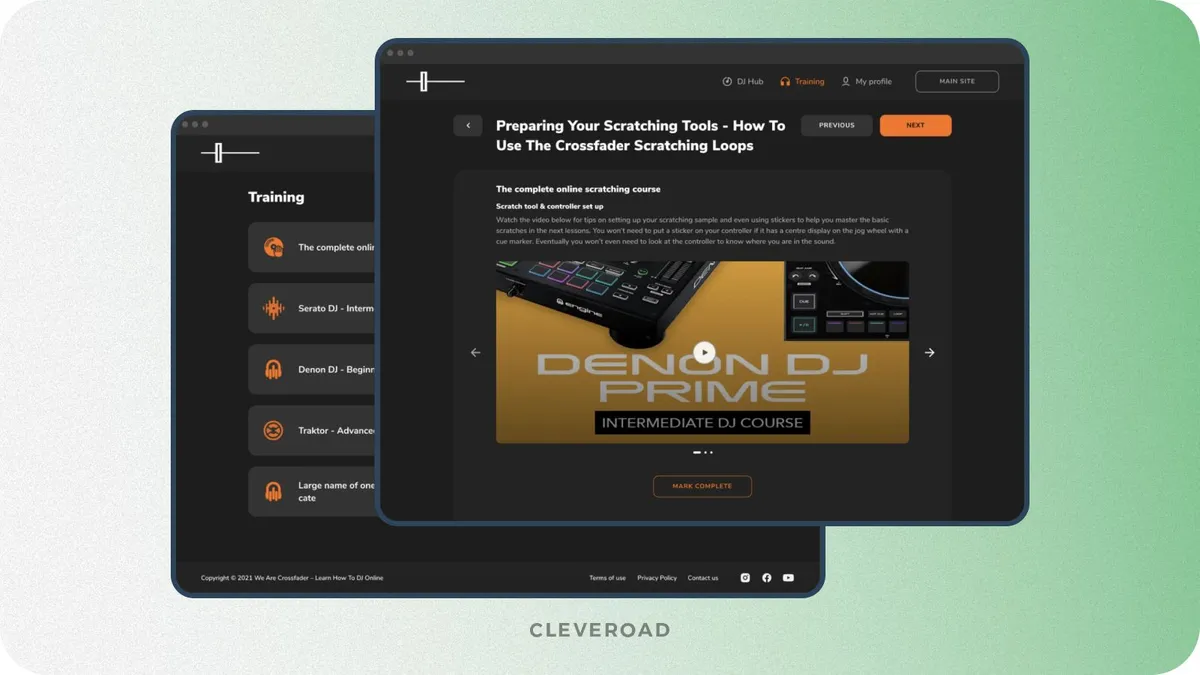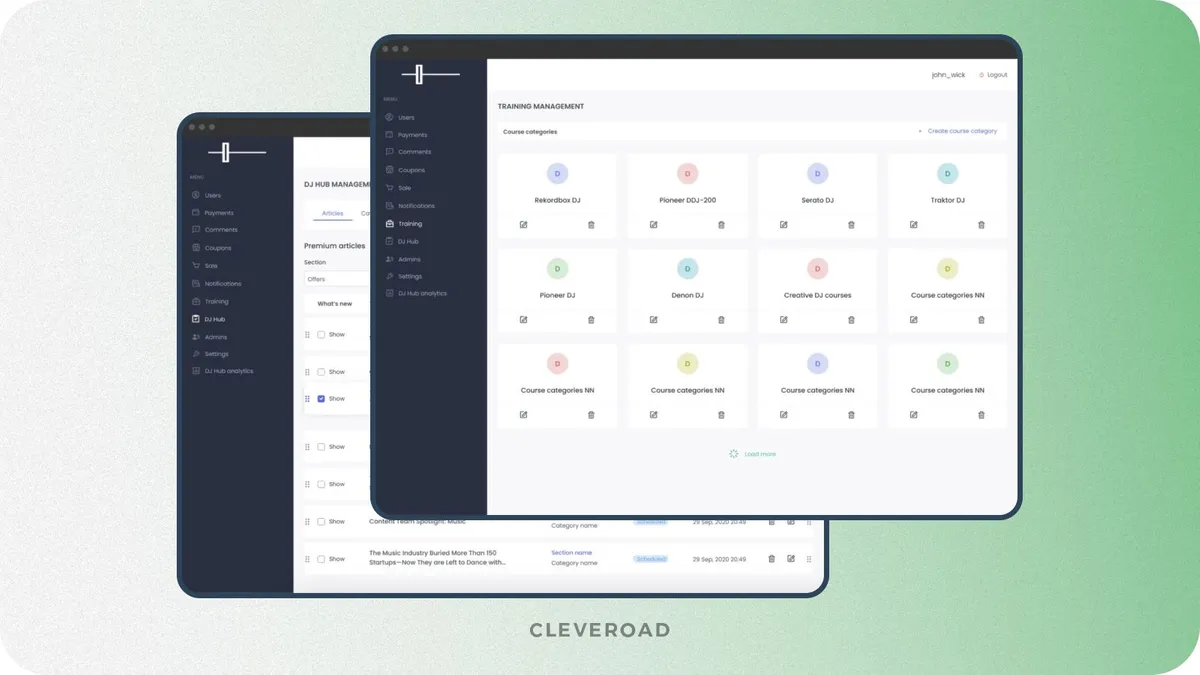How to Build e-Learning Website: Business Models, Core Features, and Cost
Updated 26 Mar 2024
15 Min
21431 Views
More and more traditional academic institutions are turning to e-learning website development to integrate it into their curriculum to provide students with learning materials, homework assignments, and allow them to access courses from anywhere at any time. No wonder more and more educational startups are rising here and there, and most have unique ideas, features, and capabilities.
So, how to create e-learning website that will succeed? As a professional education software development company, we at Cleveroad are ready to share with you the basic aspects of building an e-learning website - you will learn how to build educational platform, which features to include, business models to choose from, and the development cost.
What Is an e-Learning Platform: Essence and Types
An e-learning website is a platform created to deliver educational content and training materials online. An E-learning app or website serves as a centralized hub where learners can access course materials, participate in interactive activities, collaborate with peers, and engage with instructors or facilitators. The purpose of e-learning website development lies in its ability to provide flexible, accessible, and personalized virtual learning experiences that meet diverse student needs.
Here’s what great online learning platform should do:
- Contain lots of helpful educational materials and deliver excellent learning experience to students
- Make user-platform interactions seamless, smooth, and bug-free
- Offer learners to track their progress in real time
And the most popular educational apps that meet these criteria are Coursera, Udemy, edX, and Udacity. These e-learning platforms belong to online course marketplaces – they let students take courses independently, according to learners’ preferences and fields they are interested in.
E-learning marketplaces rarely have any limitations on the form of content. This type of platform combines textbooks, educational videos, exercises, games, podcasts, etc. The platforms give materials gradually, piece by piece, so that students won’t be overwhelmed by tons of exercises and tasks.
Types of e-learning platforms
There are many types of educational platforms. The most common of them are:
Online course marketplaces. These platforms offer various courses across various subjects, often created by instructors or educational institutions. Examples include Coursera, Udemy, LinkedIn Learning, Skillshare, and Udacity.
Language learning apps. These apps focus on teaching users new languages through interactive lessons, quizzes, and practice exercises. Examples include Duolingo, Babbel, Rosetta Stone.
Tutoring platforms. Tutoring apps connect students with tutors for one-on-one or group sessions in various subjects. Examples include Chegg Tutors, Wyzant, Varsity Tutors, and Tutor.com.
Educational games. These apps gamify learning by incorporating educational content into engaging games and activities related to eLearning. Examples of leading elearning games include Kahoot!, QuizUp, ABCmouse, and Mathletics.

Types of e-learning platforms with examples
Benefits of e-Learning Website Development
Building an e-learning website provides multiple advantages for all the participants: business owners, teachers and students. Let’s check how you can benefit from e-learning website development:
Accessibility
E-learning website will solve the problem of barriers to education by offering learning materials online, allowing for asynchronous learning. Learners can study independently, fitting learning around their existing commitments. This flexibility of online education website will help with learning solutions for working educators, students with busy schedules, or those with mobility limitations. To make educational materials even more accessible, consider e-learning application development that allows students to study using only their mobile phones.
Cost-effectiveness
Compared to traditional classroom-based training, e-learning reduces costs associated with physical resources like textbooks, printed materials, and facilities. Once developed, digital content can be distributed to unlimited learners without incremental expenses, making it a cost-effective solution for many eLearning organizations seeking to train large audiences.
User engagement
Interactive features like quizzes, simulations, and multimedia content enhance learner engagement and motivation. By incorporating gamification elements like badges, leaderboards, and rewards, e-learning platforms make learning more enjoyable and encourage active participation. Engaged learners are more likely to retain information and achieve better learning outcomes.
Personalization
E-learning website development allows personalized learning experiences tailored to each learner's preferences, learning style, and proficiency level. Adaptive elearning technologies track learner progress and dynamically adjust the content to meet individual needs. This personalized approach maximizes learner engagement and ensures that each student receives the support they need to succeed.
Analytics and tracking
E-learning platforms provide educators with valuable insights into learner progress, performance, and engagement to the website using analytics tools. Educators can track learner activity, identify areas of strength and weakness, and intervene when necessary to support struggling students. Data-driven insights enable continuous improvement of course content and instructional strategies, leading to better learning outcomes and increased student satisfaction.
Global reach
E-learning website development allows to potentially reach an international audience, transcending geographical boundaries. Organizations can deliver educational content to learners worldwide, expanding their reach. This global accessibility opens up new opportunities for collaboration, knowledge sharing, and cultural exchange, enriching the learning experience for all participants.
Essential Features of the e-Learning Platform
How to make e-learning website? It is crucial to focus on the functionality of your educational solution so that it can be successful amongst the many competitors. You can add some unique features based on user feedback, but you should start by building a Minimum Viable Product (MVP) that includes the most essential functionality for your platform.
Let’s take a quick look at the MVP features of an e-learning platform:
- Authentication and user profile.
- Filtering system
- Dashboard
- Course page
- Payment systems
- Course adding page (for tutors)
- Notifications and reminders
- Admin panel
Registration & profile management
Building an online learning platform should include a registration module for both students and teachers. Users need to create an account to get access to the website materials and features. The most popular way is by using email/phone number and password combination. Still, singing in via social networks accounts like Facebook or Google is quite fast, convenient and widely used too.
As for profile management, the number of features depends on profile owner. When building an elearning website, you should include the following details into the learners’ account:
- User info and profile pic
- List of active/completed courses
- Information about certificates/points/credits
- Purchase history
- Settings page
And the teacher's profile should have:
- Info page (with information about degree or establishment they represent)
- List of added courses
Dashboard
The custom eLearning dashboard helps both students and teachers to track their progress and get useful insights about their studies or work. For instance, students see the number of courses they’ve enrolled in, their completion status, the number of hours they've spent on a course, etc. Teachers can also check courses they've added, the number of enrolled students, ratings, traffic, and earnings.

Dashboard feature example designed by Cleveroad (Source: Dribbble)
Search filters
Building an elearning website implies a catalog of courses. When talking about large website like Udemy, users would need a tool to search through them.
An e-learning website development should cover the following tools:
- Search bars where users enter keywords
- Categories on the main page
- Filters (by level, price, language, rates, difficulty level of the course, etc.)
- Recommending similar or most popular courses to students
Course page
If you aim to create an effective elearning website, you should understand that it can't achieve success without great content. Most courses on online learning websites include materials like videos, podcasts, recordings, interactive textbooks, and even chats. If you are wondering how to create an online learning platform and make it sought-after in the eLearning market, keep in mind that lots of platforms add gamification elements that help to engage students. Every course should have description, info about its creators, and the list of topics and materials.

Course page feature example developed by Cleveroad
Payment methods
If you build an elearning platformbased on paid courses, there should be a convenient way for students to pay for them, and for teachers – to collect their earnings. And mind that when you're dealing with money, it's worth taking some time to look for secure payment methods.
For now, the most popular payment means within the question of how to create e learning website are:
- Debit/credit cards
- PayPal
- Stripe or Braintree
Choosing a reliable payment system? Take a look at our Paypal vs. Stripe vs. Braintree comparison to find out which option suits your business best of all.
Course-making & editing page
Elearning platform development should include functionality allowing teachers to create and publish courses. A successful platform should have reliable and convenient course-building tools to provide a wide range of courses. These education website tools should allow teachers to create create their courses structure and add materials, exercises, and links to additional resources on the website like PDFs, videos, audio files, etc.
Notifications and reminders
Online educational platform can inform users about new courses, recommendations, events in global elearning market, or updates by sending them emails or app notifications. The trick is to do it timely and gently. For example, sending emails notifying you about each new course is rather a bad idea. Yet, a monthly digest with personal recommendations is something most users will find helpful.
Admin panel
If you want to develop an e-learning website, you need to build an admin panel that gives administrators complete control over the content and functionality of the site. With its help, they can manage courses, content, users, and payments, receive reports on user activity and finances, and monitor the overall effectiveness of the web platform.

Example of e-learning platform admin panel created by Cleveroad
How to Make E-learning Website?
Now let's understand how to create your own e-learning website and review the main steps for creating eLearning courses platform. Here's a step-by-step guide on educational website development:
1. Study your target audience and define your niche
Each e-learning application development starts with research. First, analyze your niche and target audience. Here are the main points to check:
- age
- interests
- how they spend their free time
Then, think about personalized content. Define the topics you'd like to cover and learn what content will be engaging and helpful for future students.
Based on this information, define a niche within the e-learning market that aligns with these insights. This niche could be based on specific subjects, industries, learning styles, or demographics. By focusing on a specific niche, you can better tailor your content and offerings to meet the needs of your target audience, increasing the likelihood that you develop a website for e-learning successfully.
2. Choose a business model
Choosing the right business model at the early stage of e-learning platform development is crucial, as it determines the basic principles of monetization and influences the product development strategy. The decision about the business model not only determines the ways of revenue generation but also shapes the relationships with users and partners.
There are several types of business models for e-learning platforms:
- Subscription-based model. Users pay a monthly or annual fee to access all courses on the platform. Example: Coursera, LinkedIn Learning.
- Pay per course model. Users pay for access to specific classes or modules. Example: Udemy, Skillshare.
- Freemium model. Primary access to the platform is complimentary, while additional features or advanced courses are charged. Examples: Khan Academy, Duolingo.
3. Find a reliable IT partner
Once you’re done with planning, you can start looking for a reliable vendor that will build the e-learning website for you. One of the possible options is to hire an in-house team, but this approach requires additional costs such as rent, hardware, social benefits, salaries, etc.
It may be cheaper for you to look for software development vendors abroad rather than in a city (or even country) of residence. Outsourcing web development brings significant benefits in term of price, wide skill set, and unique expertise. Outsourcing companies already have a team of certified specialists who will rapidly deliver your solution under defined requirements. With outsourcing, you only pay for the work done with no need for extra outgoings.
If you lack only a few specialists, for example web developers and QA engineers, you can turn to Staff Augmentation. The software vendor provides you with required experts to create e-learning website.
Learn more about how to outsource programming services in our detailed guide
4. Detailing your requirements
During this phase, the vendor assists in outlining the specifics, functionalities, and technical specifications required to create an e-learning platform. They conduct thorough research, gather user feedback on similar software, and define clear objectives and goals for the development process. The vendor also creates detailed documentation, such as user stories, wireframes, and technical requirements, to effectively guide the development team.
5. UI/UX design creation
Effective design is critical if you want to create an eLearning website with an attractive and functional environment for learning and interacting with content. User experience is important as it directly affects student engagement and the number of visitors to your platform.
The UI/UX design services usually start with studying the target audience's needs and preferences and creating a general concept. Designers focus on both visual aspects and functionality to maximize usability and elearning site efficiency. Experts create mockups and prototypes, which they pass to developers after you approve them.
6. Development and testing
Development is the key stage when the team creates the code to build e-learning website, bringing to life the interface and functionality defined in the previous stages. Development is usually performed in several sprints, each tasked with creating a particular part of the functionality.
The entire development process is accompanied by Quality Assurance (QA). QA engineers thoroughly check the correctness of each function and all website elements. Upon completion of the e-learning website development, they also conduct several additional tests to ensure a learning platform that can withstand heavy loads and does not produce errors.
7. Platform release
Once an elearning website is completed and tested, the platform is ready to be released to users. This step involves deploying the platform on a live server where it can be accessed by students and teachers. The release process may also include marketing and promotional activities to attract users to the platform and generate initial interest.
8. Support and maintenance
Once the e-learning platform is released, ongoing support and maintenance is necessary for its successful operation. These services include monitoring the learning website for performance issues or bugs and promptly addressing them with updates and patches. In addition, user support and addressing any user questions and concerns is critical to maintaining user satisfaction and engagement with the platform over time. Regular updates and improvements based on user feedback and changing requirements also fall under the scope of support and maintenance to build e-learning website that will remain relevant and competitive in the ever-evolving e-learning landscape.
How Much e-Learning Web Development Costs?
Now, when you know how to create e-learning website, let's talk about price considerations. If you want to start e-learning website or LMS development with the features we've described, it may cost from $15,000 and $100,000+. That's an approximate number based on $50/h rate in Central and Eastern Europe (CEE region). These calculations are based on the approximate development time to create online learning features.
The accurate price to create e-learning website fully depends on your requirements. The more complicated the platform is, the more time developers will spend building a website functionality. Consiquently, the price to develop an eLearning website will also increase. The rough estimation made by our business analysts showed that the time required to build a successful eLearning platform ranges between 1,500h and 2,000h hours. If you plan to reach more platforms, you can decrease development time by turning to cross-platform app development services.
The rough estimation made by our business analysts showed that the time required for e-learning app development ranges between 1,500h and 2,000h hours.
And the total price depends on your vendor's country of residence:
- Central Europe. $75,000-$105,000 (based on $50/h)
- Western Europe. $150,000-$210,000 (based on $100/h)
- USA. $225,000-$315,000 (based on $150/h)
- Australia. $150,000-$210,000 (based on $100/h)
The prices we've mentioned are approximate, and they depend on the project requirements. If you'd like to find out how much time the development will take, book a call with our specialists. We’ll provide you with custom estimation of your project.
Cleveroad Expertise in E-Learning Website Development
Cleveroad is an education software development company located in one of the most popular outsourcing destinations — CEE region. Since 2011, our team has been providing Education app development services to empower learning experience for students, teachers, and administrations. We create various educational software solutions, such as Learning Management Systems (LMS), student information systems, e-learning portals, virtual classrooms, content management systems, etc.
By cooperation with Cleveroad, you are guaranteed with a variety of advantages:
- Education software development services tailored to your needs: custom EdTech software development, software reengineering, integration of third-party services, digitization of educational processes
- Experience in implementing EdTech software integrations to expand online elearning platform functionality: Adobe Captivate Prime, Inquisiq LMS, Canvas, Docebo, Moodle, SAP Litmos LMS, etc.
- Experience in developing e-learning software in adherence to educational industry standards and regulations including SCORM, xAPI, LTI, AICC, GDPR, HIPAA, CCPA, WCAG, Section 508
- All-out Project Management Office dedicated to supervising your projects to ensure timely completion, adherence to budget constraints, and alignment with your business needs
- Free Solution Workshop phase to bridge your educational objectives with technical execution. Our specialists grasp your academic requirements and workflows, customizing e-learning solutions to match your project's objectives
- Mature quality management proved by an ISO 9001 certificate to meet the quality needs of your online education platform
- ISO 27001-certified security management based on proven policies and processes to solid data security
- Flexible cooperation models to meet your eLearning portal development needs: Dedicated Team, Staff Augmentation, Time & Materials, Fixed Worksope
To illustrate our expertise in eLearning industry, here are some of our EdTech cases:
One of our online education solutions is a School App which allows students and teachers to stay connected with their school communities, making their communication two-clicks easy. The app stores all details about teachers, clubs, sports activities, and notifies users about planned events, emergencies, and so on. While working on SchoolApp, we had to deal with simultaneous development for three platforms, mobile-responsive admin panel, in-app calls, and two languages – English and Spanish.
As a result, our client received an easy-to-use and helpful app that is focused on involving students and their parents in school life wiith over 1000 downloads and 16 schools that use the platform.
Another eLearning software we’ve modernized for our client from UK is Education Platform for DJs. Solutions we’ve delivered include iOS app, new web app replacing outdated WordPress website, and an admin panel. The apps provide users with:
- Convenient access to all courses with the ability to purchase one-click access
- Multiple subscription plan options for all educational content
- Discussion of educational content
We also built an Admin panel from scratch. It allows Administration (teachers) to create courses, lessons, and Premium articles. Admins can also manage users, comments, notifications, payments, sales, and discount coupons.
As a result, our client received web and mobile applications allowing to attract wide audience, master DJs education niche and create new value streams.
Start eLearning platform development with domain experts
Our team of skillful developers with 12+ years of experience in educational software development is ready to help you create a powerful website for eLearning using modern technologies and tools
There are several steps to build an eLearning website:
- Step 1. Target audience analysis and defining niche
- Step 2. Choosing your eLearning website’s business model
- Step 3. Finding a reliable software provider
- Step 4. Detailing requirements and assembling feature list
- Step 5. Creating UI/UX design
- Step 6. Developing and testing your eLearning website
- Step 7. Releasing your educational platform
- Step 8. Supporting and maintaining your website
Basic (MVP) features of an e-learning platform:
- Authentication and user profile.
- Filtering system
- Dashboard
- Course page
- Payment systems
- Course adding page (for tutors)
- Notifications and reminders
- Admin panel
The cost of creating an e-learning website can vary depending on the features and complexity involved. Typically, you can expect the development to range from $15,000 to $100,000 or more.
The cost of hiring specialists to build an e-learning website varies depending on the vendor's country of residence:
- Central and Eastern Europe: $50 - $80 per hour
- Western Europe: $100 - $130 per hour
- USA: $150 - $180 per hour
- Australia: $100 - $1500 per hour

Evgeniy Altynpara is a CTO and member of the Forbes Councils’ community of tech professionals. He is an expert in software development and technological entrepreneurship and has 10+years of experience in digital transformation consulting in Healthcare, FinTech, Supply Chain and Logistics
Give us your impressions about this article
Give us your impressions about this article
Comments
11 commentsThis is very informative article which has given me some good ideas being knowledgeable in this new arena.
Thanks for this very insightful piece
Good Blog! Thanks for sharing this wonderful tips.
Thanku for Sharing good content.

Glad you liked it and thank you for the feedback!
How do I log in to this site I love to get more info about ot

Hello Stephanie! If you have an e-learning app or website in mind and need our assistance, please get in touch with our Business Analysists
This article has complied the whole flow of e-learning & detailed out the steps in a precise way! It has been very helpful to understand the end-to-end process!
Wow! an interesting read
this blog is good, I will like to know more about the blog
This blog is so well written Discussed all about what I wanted to know

Thank you, Rahul, I'm glad our blog helped you!
The blog discusses everything I wanted. Thank you
A very informative blog. This discusses right from scratch. Building a website for e-learning purpose is made easy. The features listed out enhanced my knowledge. Thank you.

Thank you, Rashmi, for being our reader:)